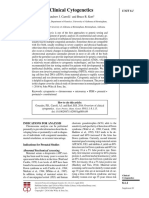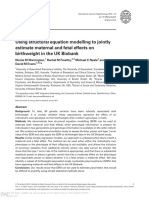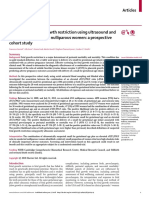1202 4509 1 PB PDF
1202 4509 1 PB PDF
Uploaded by
Muhammad FaisalCopyright:
Available Formats
1202 4509 1 PB PDF
1202 4509 1 PB PDF
Uploaded by
Muhammad FaisalOriginal Title
Copyright
Available Formats
Share this document
Did you find this document useful?
Is this content inappropriate?
Copyright:
Available Formats
1202 4509 1 PB PDF
1202 4509 1 PB PDF
Uploaded by
Muhammad FaisalCopyright:
Available Formats
Perspective
Genetics of pre-eclampsia and the weight of babies at birth – clinical
and genetic studies in Sri Lanka
V H W Dissanayake1
(Index words: pre-eclampsia, birthweight, MTHFR, F2, F5, EGF, AGT, TGFA)
Background Candidate gene disease association studies, on the
other hand, can be performed anywhere. These studies
Pre-eclampsia is the de novo occurrence of
involve prospectively recruiting cases and controls from
hypertension and proteinuria in pregnancy in an otherwise
a population, selecting a candidate gene and the genetic
normal woman [1]. Recent advances in genetics has
markers in or near the candidate gene, and then determining
resulted in a surge of investigations into genetic factors
whether the marker is found more commonly in cases than
underlying pre-eclampsia [2, 3]. These studies have been in controls using molecular genetic tests. This was the
conducted mainly among western Europeans and approach we selected for our studies of the genetics of
Japanese. The investigations reviewed in this paper were pre-eclampsia in Sri Lanka.
undertaken in a genetically distinct South Asian Sinhalese
population in Sri Lanka. Genetic markers are genetic variations. There are
various types of genetic markers. The preferred markers
Complex disorders such as pre-eclampsia are caused for case control studies are single nucleotide
by low penetrant, high frequency genetic variations in polymorphisms or single base changes in the genome [8].
several genes interacting with each other and the There are two ways of selecting candidate genes. First,
environment [2]. As a result the genetic basis of pre- positional candidates, i.e. genes located in genomic regions
eclampsia is not immediately clear [4]. Genetic traces of identified by genome wide linkage screens. Second,
pre-eclampsia could, however, be unmasked through functional candidates, i.e. genes that code for any protein
epidemiological studies, twin studies, and pedigree that is involved in the pathophysiological pathway of pre-
analysis using special techniques [5]. Epidemiological eclampsia [2].
studies show that both maternal and paternal genes, acting Candidate gene disease association studies have
through the foetus, may contribute to the development of been the popular method used to study genetics of pre-
pre-eclampsia [6]. Twin studies confirm this [7], and eclampsia. Many candidate genes across the genome have
pedigree studies report that the pattern of inheritance of been studied using this approach [3]. However, a limitation
pre-eclampsia is consistent with an autosomal dominant of these studies has been that the results in one population
pattern with reduced penetrance [4]. have not been consistently reproducible in other
Two strategies can be used to identify genes causing populations – an important consideration in true
pre-eclampsia - linkage studies and candidate gene disease associations. There are four main reasons for this. Firstly,
association studies [5]. Linkage studies involve recruiting there are issues relating to the definition of pre-eclampsia
because blood pressure and urinary protein are variable
families with multiple affected members, and then
measurements. Establishing the diagnosis involves
identifying regions of the genome that are co-inherited
passing pre-defined thresholds or cut offs on which there
along with pre-eclampsia within the family using molecular
has been some controversy [9, 10] prior to the adoption of
genetic tests to analyse their DNA. There have been
new guidelines by the International Society for the Study
several genome wide linkage screens for pre-eclampsia. of Hypertension in 2001 [1]. Secondly, researchers fail to
Genetic loci harbouring a gene or genes involved in pre- rigorously phenotype cases. Some medical conditions and
eclampsia are as follows: 4q, 2p13, 2p25, 9p13 [2]. However obstetric states are known to increase the risk of
there is little overlap between the loci identified in different development of pre-eclampsia. Therefore, careful
populations in these screens, possibly because of genetic phenotyping is necessary when recruiting cases and
differences in populations. This highlights the importance controls for these studies. Thirdly, there is the possibility
of carrying out genetic studies in different parts of the of population admixture, i.e. the presence of different
world. However, it is not possible to carry out linkage inbreeding subpopulations within cases and controls. This
studies in many parts of the world because medical and could happen when careful attention is not paid to
geneological records that are necessary to ascertain such determination of the ethnicity of recruits and when cases
families are not widely available. and controls are not matched for ethnicity. Finally, most
1
Human Genetics Unit, Faculty of Medicine, University of Colombo, Sri Lanka.
Correspondence: VHWD, e-mail <vajirahwd@hgucolombo.org>. Received 6 August 2008 and revised version accepted
10 January 2009. Competing interests: none declared.
90 Ceylon Medical Journal
Perspective
studies do not have sufficient numbers of cases and that the birthweight of babies born to women who had
controls, making them underpowered to detect any genetic uncomplicated pregnancies was associated with the
effect [11]. We were mindful of these problems when we mother's epidermal growth factor genotype [15].
began our studies into the genetics of pre-eclampsia in Sri The maternal-fetal interface in pregnancy is unique.
Lanka. It is the only site in an organism where genes from the
mother and genes from the father, acting through the
Genetic studies in Sri Lanka foetus, interact. To study this interaction the genetic make
up of the father, the mother and the foetus or the baby –
By applying a strict definition for pre-eclampsia and the so called parent-child trios – has to be investigated
rigorous exclusion criteria, we recruited a group of women [17, 18]. When we genotyped these trios and analysed
who were carefully phenotyped for pre-eclampsia. The the data we found that chromosomes that contained the
issue of population admixture was addressed as far as 61G and 2566A alleles of the EGF gene or the 61G/2566A
possible [12,13,14]. A sample size of 180 cases and 180
haplotype which is associated with lower birthweight, was
controls was calculated to have adequate power to detect
preferentially transmitted by heterozygous parents to their
a doubling of risk of pre-eclampsia when the susceptibility
growth restricted babies [15].
allele of the genetic marker that increased pre-eclampsia
risk ranged from 0.1 to 0.5, using a dominant model, at a
significance level of p=0.05 with 80% power. Conclusions
Our findings may have important implications when
Candidate gene studies taken in the context of the Barker hypothesis [19]. The
premise of the Barker hypothesis is that adult onset
We selected candidate genes after a review of
disorders have origins in foetal life. Birthweight, which is
scientific writing. They were methylenetetrahydrofolate
the surrogate marker for development in foetal life, is an
reductase (MTHFR), prothrombin (Factor II, F2), factor V
important predictor of health. Low birthweight is related
(F5), angiotensinogen (AGT), transforming growth factor
to an increased risk of diseases in adult life, including
alpha (TGFA), epidermal growth factor (EGF). We selected
cardiovascular disease, hypertension and diabetes. It
both positional (TGFA and EGF) and functional (MTHFR,
raises the question, therefore, whether the epidermal
F2, F5, TGFA, EGF, AGT) candidates. We selected genes
growth factor gene could be the link between low
that have been studied previously (MTHFR, F2, F5, AGT)
birthweight and adult onset disorders. If it turns out to be
and genes that have not been studied previously (TGFA
so, epidermal growth factor would be a potential molecular
and EGF). Next we selected the genetic markers. They
target for targeted therapy to prevent these adult onset
were all single nucleotide polymorphisms. They were as
disorders.
follows: MTHFR 677C>T, 1298A>C, 1317T>C, 1793G>A;
F2 20210G>A; F51691G>A, 4070A>G; TGFA 3822G>A;
3827T>C, 3851T>C; EGF 61G>A, 2566G>A;AGT 174T>M, Acknowledgements
235M>T, 11535C>A.
I wish to acknowledge my supervisors, co-
Results of genotyping the population based DNA investigators, obstetricians at the De Soysa Hospital for
collection for the genetic markers showed that MTHFR Women and the Castle Street Hospital for women (2001 -
1317T>C and F2 20210G>A were not polymorphic in our 2003) and their staff, the women who took part in these
population [15,16]. The susceptibility allele frequencies investigations, Prof. Rohan Jayasekara for critical appraisal
of the Tamils and Moors were similar to that of the
of the manuscript, and funding from the President's Fund
Sinhalese. Therefore, any unsuspected population
of Sri Lanka, University of Colombo, University of
admixture would not affect the results of our candidate
Nottingham, SLMA Glaxo-Welcome Research Award 2001,
gene disease association studies. The results of our
National Science Foundation Grant No: 2004/SIDA/BT/
candidate gene disease association studies showed that
01 and IRQUE project research grants, Faculty of Medicine,
the G allele of the 2566G>A polymorphisms in the EGF
Colombo 2006.
gene increased the risk of pre-eclampsia. Women who were
homozygous for the allele had almost doubling of risk
[OR (95% CI) = 1.87 (1.05-3.31) [17]. References
1. Brown MA, Lindheimer MD, de Swiet M, et al. The
Genetics of birth weight classification and diagnosis of the hypertensive disorders of
pregnancy: statement from the International Society for the
The collection of extensive clinical and genetic data
Study of Hypertension in Pregnancy (ISSHP). Hypertension
opens up opportunities for innovative analyses. We
in Pregnancy 2001; 20: IX-XIV.
decided to explore the contribution of genetic variants to
the weight of babies at birth. The birthweight of babies 2. Chappell S, Morgan L. Searching for genetic clues to the causes
born to women with pre-eclampsia is usually low. We found of pre-eclampsia. Clinical Science 2006; 110: 443-58.
Vol. 54, No. 3, September 2009 91
Perspective
3. Lachmeijer AM, Dekker GA, Pals G, et al. Searching for test for proteinuria in pregnancy in developing countries: a
pre-eclampsia genes: the current position. European Journal method validation study. British Journal of Obstetrics and
of Obstetrics and Gynaecology and Reproductive Biology Gynaecology 2004; 111: 491-4.
2002; 105: 94-113.
13. Dissanayake VHW, Samarasinghe D, Morgan L, et al. An
4. Arngrimsson R, Bjornsson H, Geirsson RT. Analysis of analysis of the reasons for non-participation of subjects
different inheritance patterns in pre-eclampsia/eclampsia referred for recruitment for the Inherited Factors in Pre-
syndrome. Hypertension in Pregnancy 1995; 14: 27-38. eclampsia study (IFPE Study). Sri Lanka Journal of
Obstetrics and Gynaecology 2004; 26: 28-9.
5. Lander ES, Schork NJ. Genetic dissection of complex traits.
Science 1994; 265: 2037-48. 14. Dissanayake VHW, Samarasinghe HD, Morgan L, et al.
Morbidity and mortality associated with pre-eclampsia at
6. Esplin MS, Fausett MB, Fraser A, et al. Paternal and two tertiary care hospitals in Sri Lanka. Journal of Obstetrics
maternal components of the predisposition to pre-eclampsia. and Gynaecology Research 2007; 33: 56-62.
New England Journal of Medicine 2001; 344: 867-72.
15. Dissanayake VHW, Tower C, Broderick A, et al. Poly-
7. Salone Ros H, Lichtenstein P, Lipworth L, Cnattingius S. morphism in the epidermal growth factor gene is associated
Genetic effects on the liability of developing pre-eclampsia with birthweight in Sinhalese and white western Europeans.
and gestational hypertension. American Journal of Medical Molecular Human Reproduction 2007; 13: 425-9.
Genetics 2000; 91: 256-60.
16. Dissanayake VHW, Jayasekara RW, Seneviratne HR, et al.
8. Gray IC, Campbell DA, Spurr NK. Single nucleotide A study of three candidate genes for pre-eclampsia in a
polymorphisms as tools in human genetics. Human Sinhalese population from Sri Lanka. Journal of Obstetrics
Molecular Genetics 2000; 9: 2403-8. and Gynaecology Research. In press.
9. Redman CW, Jefferies M. Revised definition of pre- 17. Mitchell LE. Differentiating between fetal and maternal
eclampsia. Lancet 1988; 1: 809-12. genotypic effects, using the transmission test for linkage
disequilibrium. American Journal of Human Genetics 1997;
10. Davey DA, MacGillivray I. The classification and definition 60: 1006-7.
of the hypertensive disorders of pregnancy. American
Journal of Obstetrics and Gynaecology 1988; 158: 892-8. 18. Spielman RS, McGinnis RE, Ewens WJ. Transmission test
for linkage disequilibrium: the insulin gene region and insulin-
11. Lalouel JM, Rohrwasser A. Power and replication in case- dependent diabetes mellitus (IDDM). American Journal of
control studies. American Journal of Hypertension 2002; Human Genetics 1993; 52: 506-16.
15: 201-5.
19. Barker DJ, Winter PD, Osmond C, et al. Weight in infancy
12. Dissanayake VHW, Morgan L, Broughton Pipkin F, et al. and death from ischaemic heart disease. Lancet 1989; 2:
The urine protein heat coagulation test – a useful screening 577-80.
92 Ceylon Medical Journal
You might also like
- 1 s2.0 S2589933323003452 MainDocument10 pages1 s2.0 S2589933323003452 MainimedamNo ratings yet
- Biological Approach Edexcel Psychology Unit 2Document62 pagesBiological Approach Edexcel Psychology Unit 2Similan ChalermthanakomNo ratings yet
- Anxiety Disorders During Childhood and Adolescence Origins and TreatmentDocument33 pagesAnxiety Disorders During Childhood and Adolescence Origins and TreatmentCellaNo ratings yet
- Genetics of Pre-Eclampsia and The Weight of Babies at Birth - Clinical and Genetic Studies in Sri LankaDocument3 pagesGenetics of Pre-Eclampsia and The Weight of Babies at Birth - Clinical and Genetic Studies in Sri LankaMuhammad FaisalNo ratings yet
- Placental Transcriptomic Signatures of SpontaneousDocument18 pagesPlacental Transcriptomic Signatures of SpontaneousadeNo ratings yet
- ArtículoDocument8 pagesArtículoLaura GuevaraNo ratings yet
- Sistema Inmune Fetal y Factores Angiogénicos. Diferencias Según Sexo Fetal PDFDocument12 pagesSistema Inmune Fetal y Factores Angiogénicos. Diferencias Según Sexo Fetal PDFVictor AyalaNo ratings yet
- DUDDING Et Al-2008-Journal of Thrombosis and HaemostasisDocument8 pagesDUDDING Et Al-2008-Journal of Thrombosis and HaemostasisNur Ainatun NadrahNo ratings yet
- Artigo 01 - Nihms-1753553Document16 pagesArtigo 01 - Nihms-1753553Pedro AfonsoNo ratings yet
- 61 Goepfert2004Document7 pages61 Goepfert2004angela_karenina_1No ratings yet
- Senapati2018 Article SuperovulationAltersTheExpressDocument10 pagesSenapati2018 Article SuperovulationAltersTheExpressInneke NoerNo ratings yet
- Paternal Factors in Spontaneous First Trimester Miscarriage: Original ArticleDocument5 pagesPaternal Factors in Spontaneous First Trimester Miscarriage: Original ArticleFaradiba NoviandiniNo ratings yet
- PDFDocument137 pagesPDFPeter Osundwa KitekiNo ratings yet
- Preeclampsia at Term Can Be Classified Into 2 Clusters With DifferentDocument24 pagesPreeclampsia at Term Can Be Classified Into 2 Clusters With DifferentJossiel OlivaresNo ratings yet
- Gao 2024 Prenatal Dx - Prenatal exome sequencing for morphologically normal fetus, should we be doing itDocument7 pagesGao 2024 Prenatal Dx - Prenatal exome sequencing for morphologically normal fetus, should we be doing itdavidgipson29No ratings yet
- tmp647F TMPDocument13 pagestmp647F TMPFrontiersNo ratings yet
- The Genetics and Clinical Outcomes in 151 Cases ofDocument7 pagesThe Genetics and Clinical Outcomes in 151 Cases ofzeni okta wiyantiNo ratings yet
- Preeclampsia Association of Placental Nucleotide Variations Genes in Latin American Pregnant WomenDocument6 pagesPreeclampsia Association of Placental Nucleotide Variations Genes in Latin American Pregnant Womenvirginia.mirandaNo ratings yet
- Reyes - Unit 2 (Part 2)Document4 pagesReyes - Unit 2 (Part 2)Justine Ericca ReyesNo ratings yet
- 2015 ART DiseasesDocument6 pages2015 ART Diseasesmuhammad neyaziNo ratings yet
- Antecedents of CPDocument8 pagesAntecedents of CPЯковлев АлександрNo ratings yet
- Wells 2003Document12 pagesWells 2003puspitaNo ratings yet
- 2018 SEM Dir WarringtonDocument13 pages2018 SEM Dir Warrington6k7m8vfjm8No ratings yet
- 21-Archives of Gynecology and Obstetrics - 2019 - SistiDocument5 pages21-Archives of Gynecology and Obstetrics - 2019 - SistiSara PaccosiNo ratings yet
- Female Genomics Infertility and Overall Health Joshi 2017Document8 pagesFemale Genomics Infertility and Overall Health Joshi 2017Orlando CuellarNo ratings yet
- No 3Document16 pagesNo 3Bian DaraNo ratings yet
- Association of Plasminogen Activator Inhibitor-Type 1 (-675 4G/5G) Polymorphism With Pre-Eclampsia: Systematic ReviewDocument9 pagesAssociation of Plasminogen Activator Inhibitor-Type 1 (-675 4G/5G) Polymorphism With Pre-Eclampsia: Systematic ReviewalyneNo ratings yet
- Genes: Modulation of Placental Gene Expression in Small-for-Gestational-Age InfantsDocument23 pagesGenes: Modulation of Placental Gene Expression in Small-for-Gestational-Age InfantsLuciani Magdalena Palacios GarcíaNo ratings yet
- Cardiovascular Risk in Hypertension Open Question 13Document2 pagesCardiovascular Risk in Hypertension Open Question 13Nurulhuda RashidNo ratings yet
- Human Genetic Screening_1590691142348Document5 pagesHuman Genetic Screening_1590691142348steveNo ratings yet
- PSTK 2Document6 pagesPSTK 2subhashbhukyaNo ratings yet
- Pediatrics 2014Document14 pagesPediatrics 2014Randy PrayogoNo ratings yet
- 2023 - Genetic Mechanisms of Fertilization Failure and Early Embryonic Arrest - A Comprehensive ReviewDocument33 pages2023 - Genetic Mechanisms of Fertilization Failure and Early Embryonic Arrest - A Comprehensive Reviewzhaoyan882No ratings yet
- Clinical Risk Factor For Preeclamsia in Twin PregnanciesDocument8 pagesClinical Risk Factor For Preeclamsia in Twin PregnanciesLouis HadiyantoNo ratings yet
- 33873-Article Text-121761-1-10-20170831Document6 pages33873-Article Text-121761-1-10-20170831AnggaNo ratings yet
- Genetic Origin of Low Birth WeightDocument7 pagesGenetic Origin of Low Birth WeightCorina CiobanNo ratings yet
- Kim - Taiwan J Obstet Gynecol - 2017Document5 pagesKim - Taiwan J Obstet Gynecol - 2017Sayedur RahmanNo ratings yet
- Aggarwal Et Al. Fetal Pediatr Pathol 2018Document21 pagesAggarwal Et Al. Fetal Pediatr Pathol 2018ShagunNo ratings yet
- Prevalence of Congenital Malformation Among Neonates Born After The Use of Progesterone For Luteal Support During IVF and ICSI CyclesDocument7 pagesPrevalence of Congenital Malformation Among Neonates Born After The Use of Progesterone For Luteal Support During IVF and ICSI Cycleseditorial.boardNo ratings yet
- Placental Expression of Imprinted Genes Varies With Sampling Site and Mode of DeliveryDocument6 pagesPlacental Expression of Imprinted Genes Varies With Sampling Site and Mode of DeliveryKarim ElghachtoulNo ratings yet
- Artigo 3Document7 pagesArtigo 3Cirineu NetoNo ratings yet
- HR 20119Document7 pagesHR 20119abha.kush28No ratings yet
- Articles: BackgroundDocument13 pagesArticles: BackgroundHartanto LieNo ratings yet
- Pregnancy Outcomes Following in Utero Exposure To Second-Generation AntipsychoticsDocument7 pagesPregnancy Outcomes Following in Utero Exposure To Second-Generation AntipsychoticsdanielaNo ratings yet
- 2021 - Voerman - Ped Obesity - Associations of Maternal & Infant Metabolite Profiles With Fetal Growth & Odds Adverse OutcomesDocument11 pages2021 - Voerman - Ped Obesity - Associations of Maternal & Infant Metabolite Profiles With Fetal Growth & Odds Adverse OutcomespaletaNo ratings yet
- European Journal of Obstetrics & Gynecology and Reproductive BiologyDocument15 pagesEuropean Journal of Obstetrics & Gynecology and Reproductive Biologybidan22No ratings yet
- Jurnal Reading ObygnDocument6 pagesJurnal Reading ObygnLimastani FebrianaNo ratings yet
- Placental Growth Factor Measurements in The AssessDocument7 pagesPlacental Growth Factor Measurements in The AssessWahyudi WirawanNo ratings yet
- Etiology of Preeclampsia: An UpdateDocument9 pagesEtiology of Preeclampsia: An UpdateSares DaselvaNo ratings yet
- Expanded Carrier Screening For Preconception Reproductive Risk Assessment: Prevalence of Carrier Status in A Mexican PopulationDocument9 pagesExpanded Carrier Screening For Preconception Reproductive Risk Assessment: Prevalence of Carrier Status in A Mexican PopulationDyahsekarayupudak wangiNo ratings yet
- Kelahiran Prematur Spontan Memajuan Menuju Penemuan Predisposisi GenetikDocument63 pagesKelahiran Prematur Spontan Memajuan Menuju Penemuan Predisposisi GenetikRismawati ArifNo ratings yet
- Fertility Treatments and Invasive Epithelial Ovarian Cancer 2015 Fertility ADocument8 pagesFertility Treatments and Invasive Epithelial Ovarian Cancer 2015 Fertility Ajayeto4038No ratings yet
- DNA Methylation and DevelopmentDocument4 pagesDNA Methylation and DevelopmentRon HubbardNo ratings yet
- ECPM2016 ABSTRACTBOOKTheJournalofMaternal-FetalNeonatalMedicine PDFDocument314 pagesECPM2016 ABSTRACTBOOKTheJournalofMaternal-FetalNeonatalMedicine PDFDiana-Elena ComandasuNo ratings yet
- Pre EklampsiaDocument21 pagesPre EklampsiaRocky.84No ratings yet
- MTHFR Genetic Polymorphism and The Risk of Intrauterine Fetal Death in Polish WomenDocument6 pagesMTHFR Genetic Polymorphism and The Risk of Intrauterine Fetal Death in Polish WomenMauro Porcel de PeraltaNo ratings yet
- Primer: Genome-Wide Association StudiesDocument21 pagesPrimer: Genome-Wide Association Studiesrommell AlvaradoNo ratings yet
- Prevalence of Congenital Anomalies in Neonates and Associated Risk Factors in A Tertiary Care Hospital in Eastern IndiaDocument7 pagesPrevalence of Congenital Anomalies in Neonates and Associated Risk Factors in A Tertiary Care Hospital in Eastern Indiameylisa putri ayunandaNo ratings yet
- For Peer Review: Polymorphisms in Genes RFC-1/CBS As Maternal Risk Factors For Down Syndrome in ChinaDocument15 pagesFor Peer Review: Polymorphisms in Genes RFC-1/CBS As Maternal Risk Factors For Down Syndrome in ChinaRuxandra CretuNo ratings yet
- 4 - Fetalneonatal 2014 307410Document7 pages4 - Fetalneonatal 2014 307410Karina Mega WNo ratings yet
- Maternal Dyslipidemia and Risk For Preterm Birth: A1111111111 A1111111111 A1111111111 A1111111111 A1111111111Document10 pagesMaternal Dyslipidemia and Risk For Preterm Birth: A1111111111 A1111111111 A1111111111 A1111111111 A1111111111Romzy Azmy LazuardiNo ratings yet
- Endometrial Gene Expression: An Emerging Paradigm for Reproductive DisordersFrom EverandEndometrial Gene Expression: An Emerging Paradigm for Reproductive DisordersJoanne Kwak-KimNo ratings yet
- Jl. DR. Sutomo No.16, Randusari, Kec. Semarang Selatan, Kota Semarang, Jawa Tengah 50244Document6 pagesJl. DR. Sutomo No.16, Randusari, Kec. Semarang Selatan, Kota Semarang, Jawa Tengah 50244Muhammad FaisalNo ratings yet
- Ogilvie SyndromeDocument8 pagesOgilvie SyndromeMuhammad FaisalNo ratings yet
- Berat Sebanding Dengan Meningkatnya Aktivitas Yang Dilakukan Oleh Manusia Khususnya Di Bidang Industri. Logam Kadmium Digunakan Di Berbagai Bidang SepertiDocument8 pagesBerat Sebanding Dengan Meningkatnya Aktivitas Yang Dilakukan Oleh Manusia Khususnya Di Bidang Industri. Logam Kadmium Digunakan Di Berbagai Bidang SepertiMuhammad FaisalNo ratings yet
- Twin Reversed Arterial Perfusion (TRAP) Sequence Characteristic Gray-Scale and Doppler Ultrasonography FindingsDocument3 pagesTwin Reversed Arterial Perfusion (TRAP) Sequence Characteristic Gray-Scale and Doppler Ultrasonography FindingsMuhammad FaisalNo ratings yet
- Unas November 2019Document21 pagesUnas November 2019Muhammad FaisalNo ratings yet
- Mother To Child Transmission HBVDocument48 pagesMother To Child Transmission HBVMuhammad FaisalNo ratings yet
- Folate Metabolism Gene Polymorphisms MTHFR C677T and A1298C and Risk For Preeclampsia: A Meta-AnalysisDocument9 pagesFolate Metabolism Gene Polymorphisms MTHFR C677T and A1298C and Risk For Preeclampsia: A Meta-AnalysisMuhammad FaisalNo ratings yet
- Soal Soal Obstetri WilliamDocument1 pageSoal Soal Obstetri WilliamMuhammad Faisal100% (1)
- Reproduction: Placental Markers of Folate-Related Metabolism in PreeclampsiaDocument10 pagesReproduction: Placental Markers of Folate-Related Metabolism in PreeclampsiaMuhammad FaisalNo ratings yet
- Grade 3 - Day 3 PDLG PowerpointDocument67 pagesGrade 3 - Day 3 PDLG PowerpointAsmaNo ratings yet
- Psychology and Crime - UnknownDocument270 pagesPsychology and Crime - UnknownQuila Rickards100% (13)
- Allama Iqbal Open University Islamabad: Book Name (8610) Level: B.EdDocument9 pagesAllama Iqbal Open University Islamabad: Book Name (8610) Level: B.EdArshad SanwalNo ratings yet
- 1 s2.0 S0028393223000kkkkkkkkkkkkkkkkkkk57X MainDocument22 pages1 s2.0 S0028393223000kkkkkkkkkkkkkkkkkkk57X MainfacturasucacrNo ratings yet
- IB Psychology Chapter 02 Learning ObjectivesDocument13 pagesIB Psychology Chapter 02 Learning ObjectivesAndrea BadilloNo ratings yet
- Aggression Revision Essay PlansDocument32 pagesAggression Revision Essay Planstemioladeji04No ratings yet
- Do We Have Any Control Over Child Development?Document14 pagesDo We Have Any Control Over Child Development?Aisyah MusfirahNo ratings yet
- Test Bank For Experiencing The Lifespan, 6e Janet Belsky Test BankDocument38 pagesTest Bank For Experiencing The Lifespan, 6e Janet Belsky Test BankNail BaskoNo ratings yet
- Psicosis Atípica MitsudaDocument6 pagesPsicosis Atípica MitsudaRoberth SanchezNo ratings yet
- De Thi HSG Chinh ThucDocument12 pagesDe Thi HSG Chinh ThuchahaNo ratings yet
- Altruism and Aggression 1986Document7 pagesAltruism and Aggression 1986MegaaNeesh NeshNo ratings yet
- Childhood and Adolescence Voyages in Development 5th Edition by Rathus Solution ManualDocument18 pagesChildhood and Adolescence Voyages in Development 5th Edition by Rathus Solution Manualginger100% (32)
- The Nurture TheoryDocument13 pagesThe Nurture TheoryAlice DominguezNo ratings yet
- Physiology & Behavior: Clare Llewellyn, Jane WardleDocument8 pagesPhysiology & Behavior: Clare Llewellyn, Jane WardlediekoNo ratings yet
- Personality and Temperament PDFDocument10 pagesPersonality and Temperament PDFkarpanaiNo ratings yet
- Questions 5-6 Are Based On The FollowingDocument26 pagesQuestions 5-6 Are Based On The FollowingEthan HuntNo ratings yet
- Lotf Week 2 PacketDocument22 pagesLotf Week 2 Packetapi-260262236No ratings yet
- Genetic and Environmental Influences On Criminal BehaviourDocument16 pagesGenetic and Environmental Influences On Criminal BehaviourCristín Ní Liatháin100% (2)
- Nature Vs NurtureDocument56 pagesNature Vs NurtureYukti SharmaNo ratings yet
- Chapter Two: Biological Foundations: Heredity, Prenatal Development, and BirthDocument47 pagesChapter Two: Biological Foundations: Heredity, Prenatal Development, and BirthHsieh Yun JuNo ratings yet
- The Biological ApproachDocument4 pagesThe Biological ApproachTrish LauNo ratings yet
- Twin Study PP ScriptDocument4 pagesTwin Study PP ScriptKalleeNo ratings yet
- IELTS Reading Actual Feb 2023Document233 pagesIELTS Reading Actual Feb 2023ramazonxamirov100% (1)
- Basic of Human Nature: by Manisha VaghelaDocument33 pagesBasic of Human Nature: by Manisha VaghelaDayakar Padmavathi BoddupallyNo ratings yet
- Block 4 PDFDocument81 pagesBlock 4 PDFD S ThejeshNo ratings yet
- Chapter 12 - PersonalityDocument22 pagesChapter 12 - Personalityjjcosta0% (1)
- Field Methods ReviewerDocument4 pagesField Methods ReviewerjcramosNo ratings yet

































































































